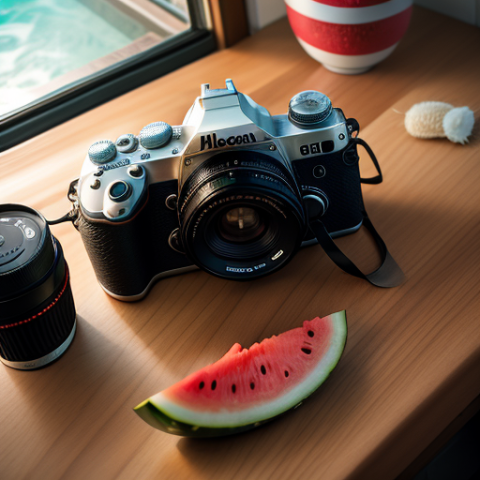Mastering the Art of Photography: Unveiling Trends and Techniques for Optimal Shots

30-12-2024, 07:53 Admin 4 464 0
Photography has continuously evolved, paralleling the technological advancements to enrich the techniques employed by photographers. In the pursuit of mastering the art of photography, one must not only excel in traditional techniques but also leverage the latest trends and resources provided by modern technology.
Today's photography transcends beyond simple point-and-shoot. Let's delve into some innovative trends and techniques that are shaping the current and future landscape of photography, crafting optimal shots like never before.
1. Computational Photography: Computational photography blends photography and computer science, producing images that were previously inconceivable. One fundamental aspect is the High Dynamic Range (HDR), a process that enhances the depth of photographs, capturing richer details in highlight and shadow regions. Smartphones like Google's Pixel series rely heavily on computational photography, rendering high-quality photos even in low light conditions.
2. Drone Photography: Offering a bird's eye perspective, drone photography breaks the boundaries of terrestrial navigation, especially for landscape shots and geographical surveys. Drones embedded with high-resolution cameras like the DJI's Phantom 4 Pro+ V2.0 allow for cinematic aerial shots, enhancing the storytelling dimensions of photography.
3. Mirrorless Cameras: Light, compact, and swift, mirrorless cameras are the new darlings of photography. Unlike DSLRs, they offer a real-time view directly from the image sensor, displayed on the rear LCD or an electronic viewfinder. Fujifilm's X-T4, for instance, offers in-body stabilization and an exceptional autofocus system, aiding in razor-sharp photography.
4. Post Processing: Tools like Adobe Lightroom and Photoshop are almost indispensable for modern photographers. These platforms let you fine-tune your output, allowing for corrections, tweaks, and embellishments that can transform an average shot into a masterpiece.
5. Immersive 360-degree Photography: 360-degree photography is proving to be a game-changer in fields like real estate and tourism, offering virtual site visits and tours. Cameras like Insta360 One X take panoramic shots in a single click, producing engrossing immersive outputs.
Efficiency throughout your process is essential to optimize your photography output. Key elements include managing the balance between ISO, shutter speed and aperture, properly organizing your digital library, and enhancing batch processing using preset functionalities in post-processing software.
Furthermore, various online platforms and resources can amplify your photography prowess. Digital Photography School, for instance, offers comprehensive insights into various techniques and trends. Additionally, portals such as Pixabay and Unsplash host a plethora of professional-level photographs that can offer inspiration for framing, composition, and lighting.
Mastering photography demands constant evolution and adaptability. As new technologies unfold, photographic techniques must evolve for photographers to succeed in their quest for those optimal shots. This constant pursuit of refinement is what truly encapsulates the art of photography. By untangling these trends and techniques, photographers can harness modern technology to its full potential, enhancing their craft and hitting the bullseye with every shot.
Today's photography transcends beyond simple point-and-shoot. Let's delve into some innovative trends and techniques that are shaping the current and future landscape of photography, crafting optimal shots like never before.
1. Computational Photography: Computational photography blends photography and computer science, producing images that were previously inconceivable. One fundamental aspect is the High Dynamic Range (HDR), a process that enhances the depth of photographs, capturing richer details in highlight and shadow regions. Smartphones like Google's Pixel series rely heavily on computational photography, rendering high-quality photos even in low light conditions.
2. Drone Photography: Offering a bird's eye perspective, drone photography breaks the boundaries of terrestrial navigation, especially for landscape shots and geographical surveys. Drones embedded with high-resolution cameras like the DJI's Phantom 4 Pro+ V2.0 allow for cinematic aerial shots, enhancing the storytelling dimensions of photography.
3. Mirrorless Cameras: Light, compact, and swift, mirrorless cameras are the new darlings of photography. Unlike DSLRs, they offer a real-time view directly from the image sensor, displayed on the rear LCD or an electronic viewfinder. Fujifilm's X-T4, for instance, offers in-body stabilization and an exceptional autofocus system, aiding in razor-sharp photography.
4. Post Processing: Tools like Adobe Lightroom and Photoshop are almost indispensable for modern photographers. These platforms let you fine-tune your output, allowing for corrections, tweaks, and embellishments that can transform an average shot into a masterpiece.
5. Immersive 360-degree Photography: 360-degree photography is proving to be a game-changer in fields like real estate and tourism, offering virtual site visits and tours. Cameras like Insta360 One X take panoramic shots in a single click, producing engrossing immersive outputs.
Efficiency throughout your process is essential to optimize your photography output. Key elements include managing the balance between ISO, shutter speed and aperture, properly organizing your digital library, and enhancing batch processing using preset functionalities in post-processing software.
Furthermore, various online platforms and resources can amplify your photography prowess. Digital Photography School, for instance, offers comprehensive insights into various techniques and trends. Additionally, portals such as Pixabay and Unsplash host a plethora of professional-level photographs that can offer inspiration for framing, composition, and lighting.
Mastering photography demands constant evolution and adaptability. As new technologies unfold, photographic techniques must evolve for photographers to succeed in their quest for those optimal shots. This constant pursuit of refinement is what truly encapsulates the art of photography. By untangling these trends and techniques, photographers can harness modern technology to its full potential, enhancing their craft and hitting the bullseye with every shot.
Related News
Leave a Comment


